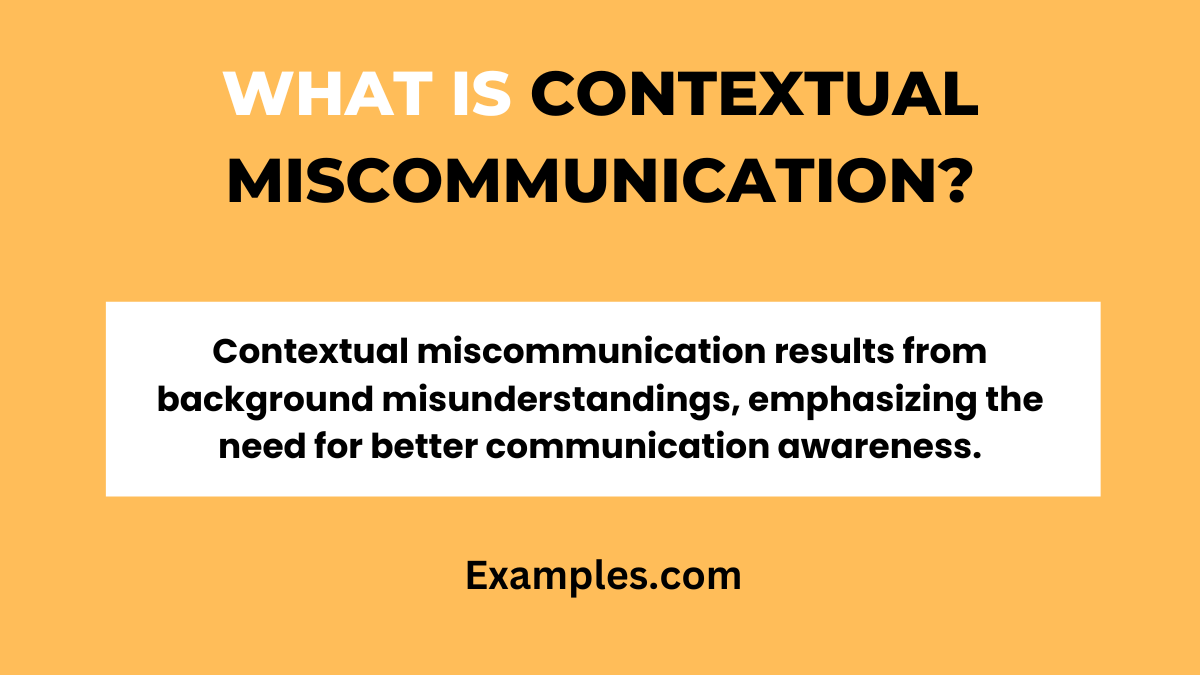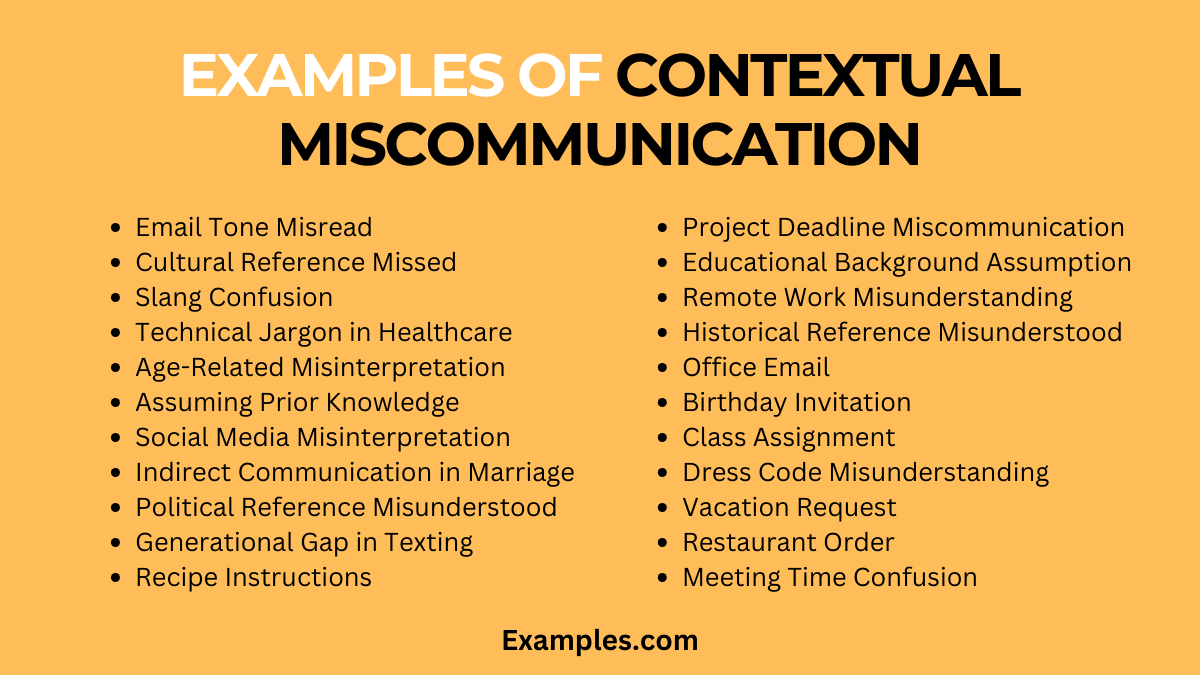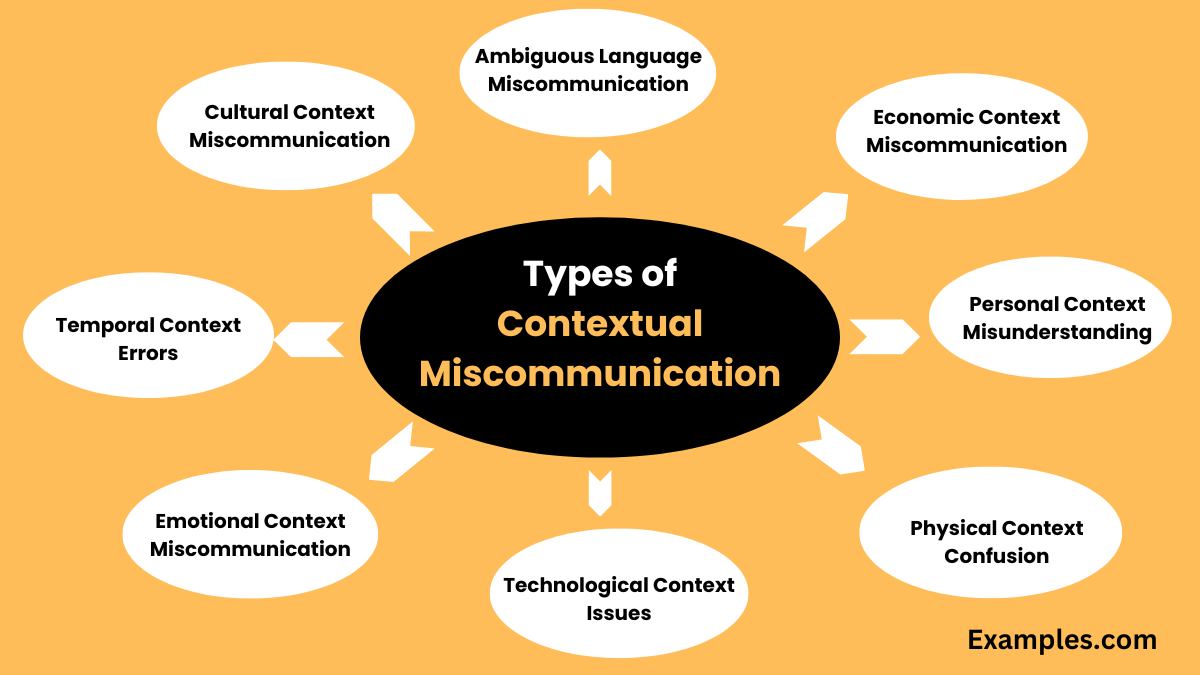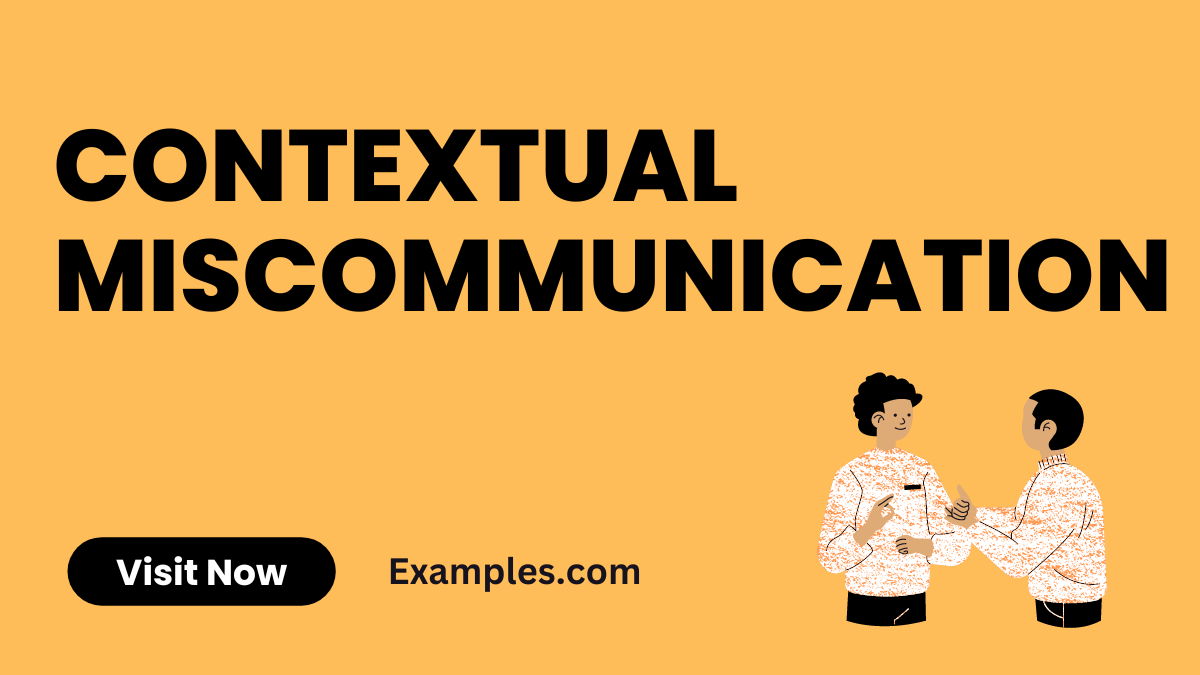14+ Contextual Miscommunication Examples
Contextual miscommunication, a prevalent issue in both personal and professional settings, often arises from misunderstandings rooted in the context of a conversation. This comprehensive guide delves into various miscommunication examples, illustrating how slight nuances in context can significantly alter the intended message. From workplace scenarios to everyday interactions, understanding the impact of context is crucial for clear and effective communication. By exploring real-life examples, this guide offers valuable insights into recognizing and addressing contextual miscommunication.
What is Contextual Miscommunication?

Contextual miscommunication occurs when the context or background of a conversation is misunderstood or overlooked, leading to a disconnect between the intended message and how it’s received. This form of miscommunication is subtle yet impactful, often arising from differences in cultural backgrounds, personal experiences, or situational awareness. It underscores the importance of considering not just the words used, but also the setting, relationship between communicators, and their shared knowledge or lack thereof. Grasping the full scope of contextual miscommunication is key to improving communication effectiveness.
What is the best Example of Contextual Miscommunication?

One classic example of contextual miscommunication is a workplace email interpreted differently by various team members. Suppose a manager sends an email stating, “Let’s move quickly on this project.” Some team members might interpret this as an immediate call to action, working overtime to meet what they perceive as an urgent deadline. Others might see it as a general encouragement, not an urgent directive. This variance in interpretation stems from individual understanding of the context – past experiences with similar emails, the manager’s communication style, and the perceived urgency of the project. This example highlights how context shapes our understanding and the potential for miscommunication when context is not clearly defined or uniformly understood.
Contextual miscommunication occurs when the context or background of a conversation isn’t clearly understood by all parties, leading to misunderstandings. It’s crucial in ensuring effective communication across various settings. This type of miscommunication is often subtle but can have significant impacts, particularly in professional environments and interpersonal interactions.
15 Contextual Miscommunication Examples

- Email Tone Misread: A manager sends an email with urgent tasks, but the tone is misinterpreted as aggressive rather than urgent.
Example: “Please note, these tasks are urgent and need your immediate attention.” - Cultural Reference Missed: A joke based on a cultural reference is misunderstood by a colleague from a different cultural background.
Example: “This joke is a reference to a popular TV show in our culture.” - Slang Confusion: Using local slang in a global team meeting, leading to confusion among international colleagues.
Example: “By ‘I’m swamped’, I mean I am very busy.” - Technical Jargon in Healthcare: A doctor uses medical jargon with a patient, causing misunderstanding about their health condition.
Example: “You have an infection, which is why you need this antibiotic.” - Age-Related Misinterpretation: An older employee misunderstands a younger colleague’s text shorthand.
Example: “LOL means ‘laughing out loud’, expressing amusement.” - Assuming Prior Knowledge: Discussing a project without providing background to a new team member.
Example: “Let me give you some background on this project first.” - Social Media Misinterpretation: Misinterpreting a friend’s post due to lack of context about their current situation.
Example: “This post is about my recent trip to Spain.” - Indirect Communication in Marriage: A spouse hints about wanting help without directly asking, leading to misunderstanding.
Example: “Could you please help me with the chores?” - Political Reference Misunderstood: Using a political reference that is misunderstood by those not following politics closely.
Example: “This is a reference to a recent policy change.” - Generational Gap in Texting: Parents misunderstanding the use of emojis in texts from their children.
Example: “This emoji means I am happy.” - Nonverbal Misinterpretation in a Meeting: Misreading a colleague’s silence as agreement.
Example: “Do you agree, or do you have any concerns?” - Project Deadline Miscommunication: Assuming everyone understands an implicit project deadline. Example: “The project deadline is next Friday.”
- Educational Background Assumption: Using academic references not understood by those with different educational backgrounds.
Example: “This theory is about how people learn.” - Remote Work Misunderstanding: Misinterpreting a colleague’s short messages as rude, not considering their busy remote work environment.
Example: “I’m currently juggling multiple tasks, hence the brief messages.” - Historical Reference Misunderstood in Class: A teacher references a historical event unfamiliar to students, leading to confusion.
Example: “Let me give you some context about this historical event.”
Contextual Miscommunication in the Workplace
- Ambiguous Instructions: When a manager gives vague instructions without specific details, employees might misinterpret the task. Providing explicit, detailed instructions can prevent this.
- Virtual Meeting Misunderstandings: In virtual meetings, without visual cues, participants may misinterpret the tone or intent of the speaker. Reiterating key points can ensure clarity.
- Email Misinterpretation: The lack of non-verbal cues in emails can lead to misinterpretation of the message’s tone or urgency. Using clear, direct language helps in conveying the correct message.
- Assumptions Based on Seniority: Junior employees might misinterpret a senior’s casual remark as a directive. Clear differentiation between casual conversation and official instructions is necessary.
- Misreading Non-Verbal Cues: Misinterpreting a colleague’s body language or facial expressions can lead to wrong assumptions about their thoughts or feelings. Direct communication can clarify these misunderstandings.
- Overlooking Cultural Differences: In diverse workplaces, cultural differences in communication styles can lead to misunderstandings. Awareness and sensitivity to these differences are important.
- Time Zone Confusions: Not specifying time zones in global teams can lead to missed deadlines or meetings. Always mentioning the time zone when scheduling meetings or deadlines is crucial.
- Project Goal Misalignment: Without a clear, shared understanding of project goals, team members might work towards different objectives. Regular team meetings to align on goals can prevent this.
Contextual Miscommunication in Business
- Client Expectation Misalignment: Misunderstanding a client’s expectations due to vague communication can lead to unsatisfactory outcomes. Regular check-ins with clear agendas can help align expectations.
- Marketing Message Misinterpretation: If a marketing campaign lacks clear context, it can be misunderstood by the target audience. Testing messages with focus groups can provide valuable insights.
- Contract Terms Ambiguity: Vague wording in contracts can lead to different interpretations and disputes. Having legal professionals review contracts can ensure clarity and mutual understanding.
- Brand Messaging Confusion: Inconsistent brand messaging across different platforms can confuse customers. A unified brand voice and clear messaging strategy are essential.
- Miscommunication During Negotiations: Misunderstanding verbal or non-verbal cues during negotiations can lead to unfavorable outcomes. Clear, open communication and confirmation of understanding are key.
- Supplier Misunderstandings: Lack of clear communication with suppliers about specifications or deadlines can lead to delays. Detailed briefs and regular communication can prevent this.
- Stakeholder Communication Gaps: Not providing complete information to stakeholders can lead to misaligned expectations and decisions. Regular updates and comprehensive reports are necessary.
- Employee Feedback Misinterpretation: Employees might misinterpret feedback if not delivered with clear context and constructively. Providing specific examples and suggestions can help in understanding.
Types of Contextual Miscommunication

- Verbal Misinterpretation: Misunderstanding the tone, inflection, or emphasis in spoken communication can alter the intended message. Repeat and confirm to ensure understanding.
- Non-Verbal Miscommunication: Body language, facial expressions, and gestures can be misinterpreted, especially in cross-cultural contexts. Clarifying intentions verbally can help.
- Written Communication Confusion: Emails and texts lacking context can be misunderstood. Providing background information and avoiding ambiguous language can prevent this.
- Assumptions in Cross-Cultural Interactions: Cultural norms influence communication styles, leading to misunderstandings. Learning about different cultural communication norms is beneficial.
- Context Loss in Virtual Communication: Virtual platforms can strip away helpful context found in in-person interactions. Extra effort in explaining and confirming understanding is crucial.
- Misreading Social Media Posts: Without context, social media posts can be misinterpreted. Asking for clarification before reacting can prevent misunderstandings.
- Silence Misinterpretation: Silence can be read as agreement, disagreement, or disinterest, depending on the context. Directly asking for opinions can clarify the meaning.
- Sarcasm Misunderstanding: Sarcasm can easily be misunderstood if the listener is not familiar with the speaker’s style. Using clear language and avoiding sarcasm in professional settings is advisable.
Effective communication is key in avoiding contextual miscommunication. Understanding the nuances of different communication types and being aware of cultural, verbal, and non-verbal cues are essential in preventing misunderstandings. Regular clarification, open dialogue, and a willingness to learn and adapt can significantly reduce the chances of miscommunication in various contexts.



